
Based purely on its geological structure alone, Greenland has what the vast majority of industry experts consider to be highly favourable conditions for the development of its own mining sector. Indeed its geographical location between Europe and the United States, combined with the high prices attainable for most of the raw materials that are present there, partially offset its absence of infrastructure and of sources of energy, and the harsh climatic conditions of the country.
DOWNLOAD
 CGRG-Greenland-SPR-Bro-s.pdf
CGRG-Greenland-SPR-Bro-s.pdf











